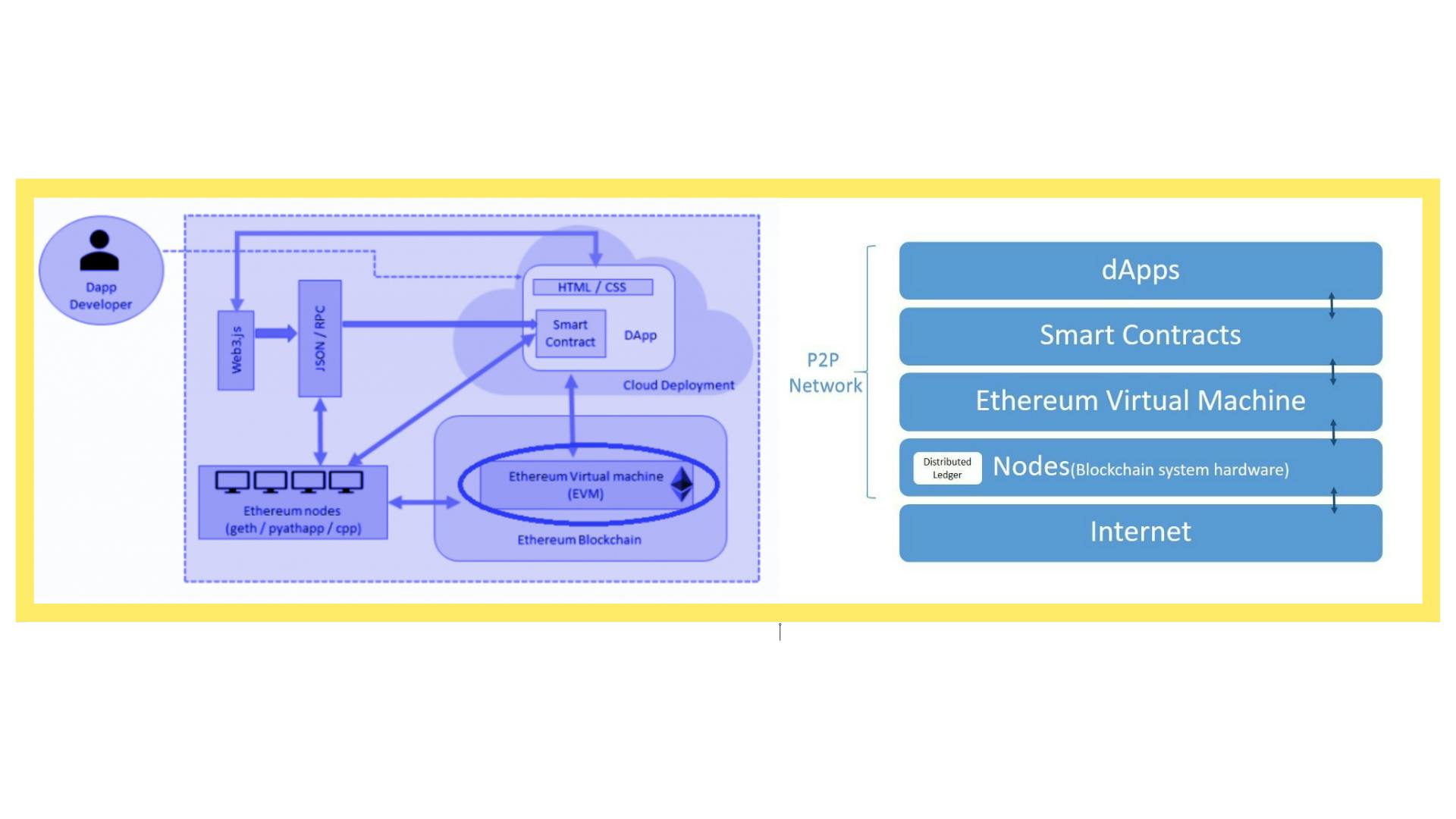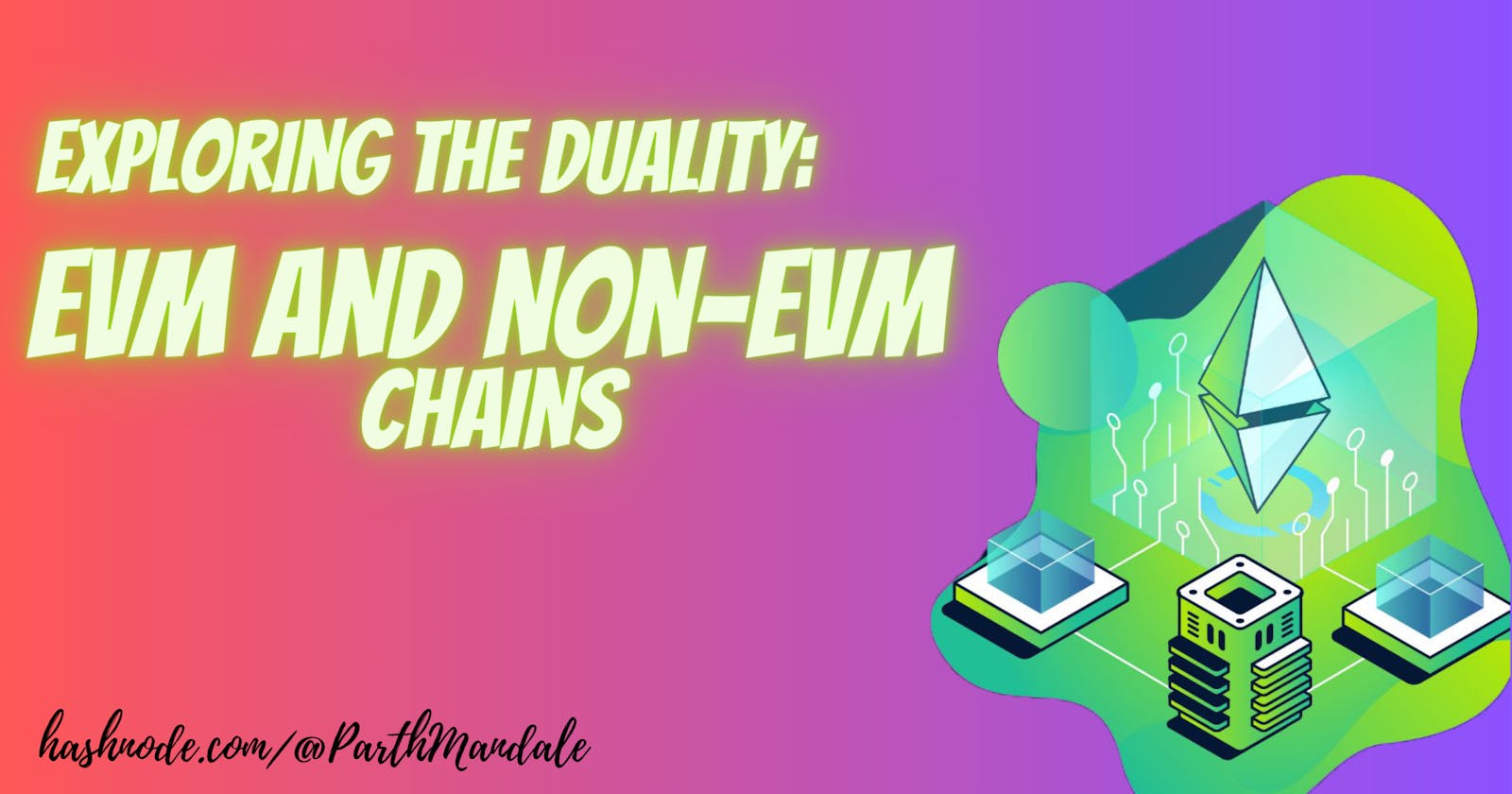Exploring the Duality: EVM and Non-EVM Chains Unveiled
"Exploring the Technologies, Features, and Use Cases of EVM and Non-EVM Chains"
Welcome to Web3.0
Welcome to my intriguing blog series on Web 3.0 Technologies! In this Third article, we'll embark on a captivating exploration of EVM and Non-EVM Chains. Say goodbye to surface-level knowledge obtained from brief internet searches, because we're diving deep into the essence of these technologies. Join me on this exciting adventure as we unravel the mysteries and gain a true understanding of EVM and Non-EVM Chains. So now, put on your thinking caps, grab a cup of coffee and get ready to expand your horizon of Knowledge!
History of Ethereum Virtual Machine(EVM)
Before directly getting into what and why and How about EVM let's have a quick go through of its History ->
Well, we all know Vitalik Buterin, the one who laid the foundation of Ethereum in 2013. Ethereum emerged as one of the best decentralized blockchain platform that revolutionized the digital landscape.
While Bitcoin primarily focused on transaction monitoring through its algorithms, Ethereum took a significant leap forward by introducing additional capabilities. One of its most notable features was the ability to store and execute smart contracts, which played a pivotal role in enabling the creation of decentralized applications (DApps). The Ethereum Virtual Machine (EVM), often referred to as the heart of Ethereum, was designed by Gavin Wood, the co-founder of Ethereum, during its early stages.
EVM (Ethereum Virtual Machine)
What exactly a Virtual Machine is?
Let's first understand what a virtual machine exactly is because once you understood it, understanding EVM would be easy.
To understand this concept more clearly, let's consider an example. Imagine you have a Windows computer, and you want to run a Linux-based application that is incompatible with Windows. Instead of purchasing a separate physical machine dedicated to running Linux, you can use a virtual machine. By installing virtualization software, such as Oracle VirtualBox or VMware, on your Windows computer, you can create a virtual machine. This virtual machine acts as a "guest" operating system within your Windows environment. You can install and run a complete Linux distribution, like Ubuntu, as if it were running on its own independent computer.

Every virtual machine differs in its capabilities and is made to operate different tasks but they share common features that make them distinct -
It offers isolation, allowing the virtual machine to operate independently of the host system. This isolation prevents conflicts between the host and guest operating systems, ensuring stability and security.
It also provides a virtualized set of hardware resources. These resources include the CPU, memory, storage, and network interfaces. Each virtual machine has its own allocation of these resources, which are separate from those of the host system. This segregation allows multiple virtual machines to run simultaneously on a single physical computer, each with its own dedicated resources. Therefore any application running on it will use the computational resources of that virtual machine and not of the computer's original OS.
It also helps developers as it compiles the high-level source code, which undergoes the compilation process that involves converting the source code into bytecode. Bytecode is an intermediate representation of the source code that is specific to the programming language being used. It is a low-level representation that captures the logic and structure of the original code in a platform-independent manner. After generating the bytecode, it can be executed on any platform that has a compatible virtual machine.
This approach eliminates the need for developers to write separate versions of the code for each specific operating system, enhancing portability and ease of deployment.
What is EVM
The Ethereum Virtual Machine (EVM) serves as the runtime environment for executing smart contracts on the Ethereum blockchain. It is a crucial component of the Ethereum ecosystem that enables the decentralized execution of code in a secure and deterministic manner.
When developers write smart contracts in high-level programming languages like Solidity, they are compiled into bytecode specific to the EVM. This bytecode represents the low-level instructions that the EVM can understand and execute. The EVM acts as a virtualized and isolated environment, separate from the underlying hardware and operating system.
One of the key advantages of the EVM is its platform independence. EVM bytecode can be executed on any machine or node that implements the Ethereum protocol. This means that the same bytecode can run on different operating systems or hardware architectures as long as they support the Ethereum network.
By providing a consistent execution environment, the EVM ensures that smart contracts behave predictably across all nodes in the Ethereum network. This consistency is essential for maintaining the trust and integrity of decentralized applications (DApps) and the broader Ethereum ecosystem.
The EVM employs a gas mechanism to manage computational resources. Gas is a measure of the computational effort required to execute a smart contract. Users pay for gas using the cryptocurrency Ether (ETH), which incentivizes efficient and economical coding practices. The gas mechanism helps prevent denial-of-service attacks and encourages developers to optimize their contracts for better performance.

Other Pros of EVM ->
(EVM) has a fault-tolerant nature: which ensures the stability and efficiency of the Ethereum network even if individual instances of the virtual machines encounter issues. In the Ethereum network, each node operates its own instance of the EVM. If one of these instances becomes corrupted or stops working, it does not create a detrimental impact on the entire network. Other nodes in the network continue to function independently, running their own instances of the EVM.
(EVM) utilizes a Merkle tree data structure to maintain the state of the Ethereum blockchain. This hierarchical storage mechanism allows for efficient retrieval, verification, and synchronization of account information. The Merkle tree's properties contribute to the integrity, efficiency, and immutability of the Ethereum network, supporting its decentralized nature and fostering trust among participants.
Non-EVM chains
In the Ethereum ecosystem, the term "Non-EVM" typically refers to code or applications that operate outside the scope of the Ethereum Virtual Machine (EVM). While Ethereum is renowned for its EVM-based smart contract execution, there are alternative blockchain platforms and smart contract environments that utilize different virtual machines to execute their own smart contracts.
Non-EVM platforms offer alternative execution environments that come with their own advantages and trade-offs. They may provide enhanced performance, scalability, or specialized features that cater to specific use cases. Additionally, these platforms may have different consensus mechanisms, governance models, or tokenomics compared to the Ethereum network.
One of the best Non-EVM chains is Solana.

Pros of Non-EVM ->
Reduced Gas Fees: Gas fees on the Ethereum network can be high during periods of high demand, making transactions costly for users. Non-EVM platforms often implement alternative consensus mechanisms and fee models, which can result in lower transaction costs. This affordability makes it more accessible for users to interact with decentralized applications and perform transactions without excessive overhead
Improved Transaction Speed: Non-EVM platforms prioritize faster transaction processing times compared to Ethereum. By utilizing different consensus algorithms and virtual machine designs, these platforms can achieve higher throughput and faster block confirmation times. This improved transaction speed enhances user experience and enables applications to handle a greater volume of transactions efficiently.
Scalability for Global Adoption: Ethereum has faced scalability challenges due to its limited transaction processing capacity. Non-EVM platforms focus on scalability solutions, such as sharding, layer-2 protocols, or alternative consensus mechanisms like proof-of-stake (PoS). These approaches allow for increased scalability, enabling the blockchain to handle a larger number of users and transactions, thereby supporting global adoption and widespread usage.
Ecosystem Diversity: The emergence of non-EVM platforms promotes a more diverse and vibrant blockchain ecosystem. Developers and users have the opportunity to explore different platforms that align with their specific requirements and preferences. This diversity encourages competition and innovation, fostering the development of novel solutions and driving advancements in the blockchain space as a whole.
Concluding both EVM and Non-EVM
Ethereum Virtual Machine (EVM) serves as the runtime environment for executing smart contracts on the Ethereum network. It provides platform independence, isolation, and a gas mechanism for secure and predictable execution. The EVM's fault-tolerant nature ensures the stability of the Ethereum network, as issues with individual instances do not harm the entire system.
On the other hand, Non-EVM platforms offer solutions to challenges faced by Ethereum, such as high gas fees and scalability. They prioritize affordability, transaction speed, and global adoption while introducing diverse features and fostering innovation in the blockchain ecosystem.
examples ->

Both EVM and Non-EVM platforms contribute to the growth and evolution of decentralized applications and the broader blockchain landscape.
"Let's stay Connected"
Twitter: Click here
LinkedIn: Click here
Email: devparthmandale915@gmail.com
Github: Click here
In the end, I would like to say that, Expanding your network can be incredibly valuable both personally and professionally. If you're interested in connecting, feel free to reach out and introduce yourself. I look forward to the possibility of building new connections and friends.
Last but not least, If you find my blog helpful you all can always support me by sponsoring me!
ThankYou!!!
#2Articles1week #Hashnode #web3 #EVM #Non-EVM
